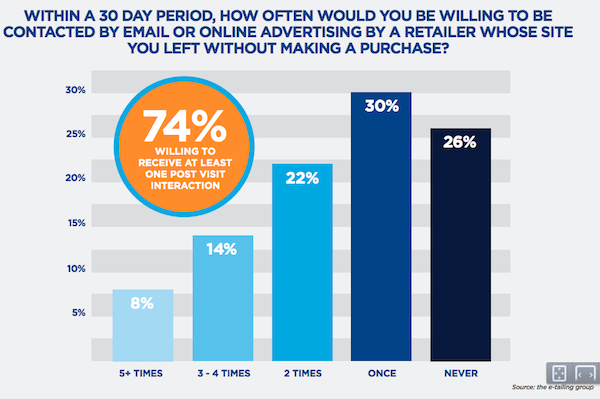Personalized Marketing Messages Pay Off for Retailers
Personalization/Targeted Ads
March 5, 2013 -- Personalized cross-channel marketing -- fashioning "offers and promotions to consumers across multiple touch points based on their past shopping or browsing experiences" -- seems to increase buyer readiness, engagement, and sales activity, according to the study, Engage Consumers & Increase Buyer Readiness Through Customer-Centric Marketing, by customer-centric marketing provider MyBuys and the e-tailing group, an ecommerce merchandising firm.
Key findings from the study of more than 1,100 online shoppers:
-
40% of respondents agree they buy more from retailers who personalize across all channels.
-
41% buy more from retailers that send them personalized promotional emails.
-
39% said they buy more from retailers that personalize web recommendations.
-
Consumers' awareness about personalized marketing is growing with two-thirds (66%) say the retailers where they shop offer promotions and merchandise tailored to their past purchasing and browsing behaviors.
-
Over half of consumers (54%) surveyed are willing to share information about themselves for more personalized shopping, and thus easily find the products and services most relevant to them.
-
Half (51%) of respondents say they are willing to share data to receive a better online shopping experience.
-
Top drivers of buyer readiness to purchase are finding the right product (67%) at the right price (55%).
-
Top online marketing messages that spur purchases:
-
Promotional email from where consumers shops (57%)
-
Search results showing local product availability (53%)
-
Personalized email from retailers where consumers shop (50%)
-
Search results with links to retail website (47%)
-
Online ads showing products from where consumers shopped (35%).
-
-
Three out of 4 consumers (74%) report they would be accepting of at least one personal email alert from a retailer after leaving a site without making a purchase.

- The study found when consumers abandon retail sites without making a purchase, it is most often because they were "still in the research process" (44%) or found it "hard to browse for the products" (33%).
- Where do consumers head to after abandoning a retailer’s site? Most often they head to Amazon (60%) and search engines (42%).
About: The study was conducted in December 2012 with 1,108 U.S. consumers completing the online survey. The gender sampling was nearly split (48% female/52% male). Participants had shopped online at least 4 times per year, spent $250 or more online annually and 95% owned a smartphone. Income breakdown: 25%< $50,000, 43% earn $50,000-100,000K, 29%>$100,000.
Source: MyBuy/the e-tailing group, Engage Consumers & Increase Buyer Readiness Through Customer-Centric Marketing, accessed March 8, 2013.





